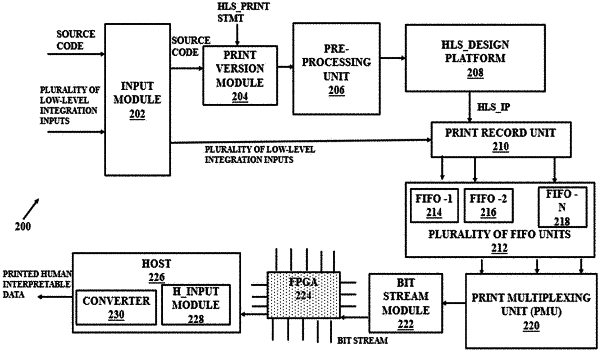| CPC G06F 8/51 (2013.01) [G06F 8/10 (2013.01); G06F 8/315 (2013.01); G06F 8/458 (2013.01); G06F 30/327 (2020.01)] | 13 Claims |

|
1. A processor-implemented method comprising:
receiving a source code associated with an IT application at a High-Level Synthesis (HLS) platform, via a one or more hardware processors, wherein the source code comprises at least a print statement with a set of print variables to be printed, the source code is associated with a source code operation frequency and the IT application utilizes a Field Programmable Gate Array (FPGA) as a processing platform that is associated with a peripheral component interconnect express (PCIe) bandwidth threshold limit;
receiving a plurality of low level integration inputs at the HLS platform, via the one or more hardware processors, wherein the low level integration inputs are associated with the FPGA and comprises a cycle counter, an application counter and a stream ID generator;
updating the source code, via the one or more hardware processors, to obtain a print version of the source code by including a set of HLS print statements;
pre-processing the print version of the source code to obtain a synthesizable source code, via the one or more hardware processors, using a source-to-source transformations based on a code generation script;
synthesizing the synthesizable source code to obtain an HLS_IP (HLS_Intellectual Property), via the one or more hardware processors, based on the source code operation frequency;
determining if the HLS_IP is within the PCIe bandwidth threshold limit, via the one or more hardware processors, based on the determination creating a plurality of print records in HLS_IP using the plurality of low level integration input, wherein a print record is created for every print variable from the set of print variables;
connecting the plurality of print records to a plurality of First in First out (FIFO) units, via the one or more hardware processors, wherein each print record from the plurality of print records is connected to a FIFO unit from amongst the plurality of First in First out (FIFO) units;
combining the plurality of print records to obtain a valid sequential print record, via the one or more hardware processors, wherein the combining includes scanning the plurality of print records using a stream combining scheme based on round robin technique;
synthesizing a Hardware Development Language (HDL) design using the HLS_IP, via the one or more hardware processors, the plurality of print records and the valid sequential print record and creating an executable bitstream of the HDL design;
sharing the executable bitstream with an FPGA, via the one or more hardware processors, for processing;
receiving the processed sequential print records from the FPGA over a PCIe at a host, wherein the processed sequential print records is in a binary format; and
converting the processed sequential print records to a human interpretable data in the host, via the one or more hardware processors, using a formatter technique and printing the human interpretable data.
|